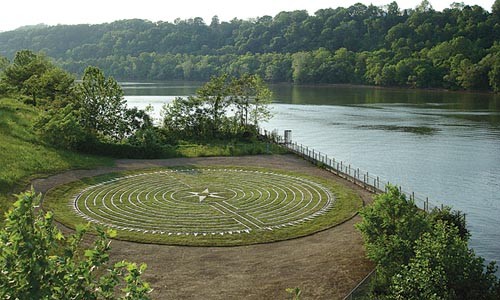The Homestead Labyrinth, a new art installation, ripples across a secluded pocket of the Monongahela riverbank, just upstream of the Waterfront megastores. Visitors can walk counter-clockwise through this wall-less inlaid stone spiral, pace around it, or -- like most every kid at the June 12 opening ceremony -- race each other to its center.
The labyrinth's architect, South Side artist Lorraine Vullo, admits that the site, just off the Great Allegheny Passage bike trail, isn't the most obvious venue.
"But something kept telling me to build it [there]," she says.
Where some public art is preoccupied with neon recalcitrance, Vullo's installation seems intent on earthy symbiosis. With its granite cobblestones that appear to bubble from the grass, the labyrinth feels like a natural appendage to the riverside.
"I wanted it to be this lovely, peaceful, sort of unassuming watercolor," she says. "I think that's why I was so drawn to the location. I didn't want to stick it in front of a building."
Vullo also gravitated to the site because it's tied to Pittsburgh's industrial past. She conceived the labyrinth partly as a memorial to lives lost in an infamous 1892 labor battle on the same grounds. The Battle of Homestead was sparked when Henry Clay Frick called in Pinkerton agents to suppress picketing steel workers.
The site is owned by Rivers of Steel Heritage Area, the organization that served as the project's fiscal agent. Ron Baraff, the group's director of museums and archives, helped Vullo select the names of about 120 historical steel facilities to engrave on concrete triangles that border the labyrinth's outermost circle. The goal, Baraff said, was "to touch as many people as possible."
A labyrinth connoisseur ("yes, they do exist," says Baraff) would notice that the 64-foot-wide labyrinth almost follows the 11-ring medieval template. The triangles are one amendment. Also, a six-pointed star at the center replaces the traditional flower.
Vullo says the labyrinth has meaning on multiple levels.
"I wanted it to be universal, yet personal," she says. "You also have the fact that it's built on this sacred historical site. I think [all three] go hand in hand."
While she says the piece is meant "for everyone," she also calls the labyrinth form an "ancient symbol" with cosmic resonance. The liberties she's taken with its design reflect the multiple meanings. The entrance, for instance, faces east (rather than the traditional west) to align with the position of the moon at her son's birth, fusing the labyrinth's cosmic and personal implications.
And while the central star "relates the piece to the heavens," Vullo reserved a triangle for her deceased father, blending Pittsburgh history with autobiography.
The Homestead Labyrinth will soon appear on the online World-Wide Labyrinth Locator, which Baraff says will attract the "hardcore labyrinth people" who travel the world to walk them.
But most visitors probably won't come with international labyrinth checklists.
"You'll have people that will come because their grandpa worked for A.M. Byers [Company]. Then you'll have the bikers that are just sort of wandering by," says Baraff. "I think it'll be a pleasant surprise."















